|
Want to know when new tips are added? Add your name to our mailing list for our e-mail updates. This list will not be sold, traded or given away.

|
|
| |
Dow Industrial Average
The Dow (INDU) is the average of the 30 leading blue-chip stocks. These blue-chips have such a high capitalization that they are often considered to be the market. Generally, the S&P 500 and the Dow will closely track one another. But this is not always the case as shown by our example below.
This multi-day divergence of the S&P 500 and the Dow was resolved on February 12 with a large, dramatic bull run in the S&P 500 (which Bulletin Signal subscribers caught). Note also that after the early price increases on the 10th, the Dow held up nicely while the S&P 500 exhibited a slow, continuing sell-off. |
|
| |
|
|
|
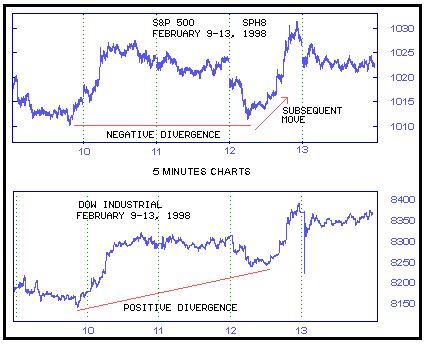
| |
Dow Transportation Index (TRAN)
The Transports are often a good leading indicator for the S&P 500, as can be seen in our next example from February 12, 1998. The two negative divergences in the S&P 500 were resolved starting at 12:00 noon with a dramatic move up in both indexes. The subsequent move up was 1500+ points in the S&P (which the Bulletin Signal subscribers enjoyed).
|
|
| |
|
|
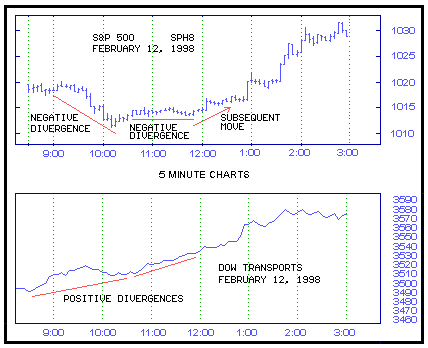
| |
TRIN (TRIN)
TRIN is a measure of the ratio of advancing to declining stocks and weighs that to the ratio of advancing and declining volume. The relative value of TRIN isnít as important as its direction. If the TRIN value is holding at a particular level, one can assume no new buying or selling is coming into the market.
If, however, TRIN is rising 5 to 8 points, it indicates selling is coming into the market place. Conversely, if TRIN is falling, say 5 to 8 points, buying is entering the market. A change of direction of the TRIN indicates a market turn.
When the market opens it is best to wait until a majority of the issues have traded before using this indicator. (A good way to know when the majority of stocks have traded is to sum the advancing and declining stocks.)
Please note that TRIN has an inverse relationship with price!
On February 9th the S&Ps made a double top at 9:00 CST.. The TRIN made a higher bottom (signifying selling coming into the market). The S&Ps sold off dramatically at this point. (Again, Bulletin Signal subscribers made money on this move.)
|
|
| |
|
|
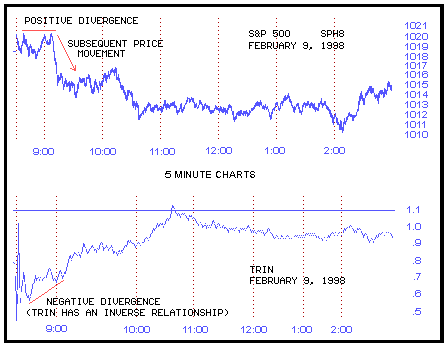
| |
Dow Industrial Tick (TICK)
If the TICKs are at extreme levels (+/- 400 points), the movement is running out of energy and offers an excellent reversal possibility.
Note when the TICKs stop rising or falling, the market frequently reverses at this time. A momentum chart of TICK can be helpful in pinpointing this action.
On February 9, the TICKs make a higher low just after 2:00 CST. This divergence resulted in a 500 point rally in the S&Ps.
|
|
| |
|
|
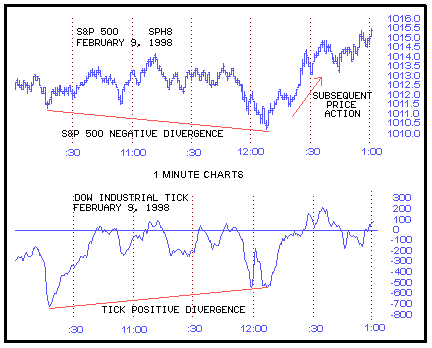
| |
S&P Premium (PREM)
This is one of the most important equity market indicators and also the most misunderstood of all indicators. The reason for this is that traders attempt to label a premium level as simply bullish or bearish. This indicator is more subtle and elegant than most and cannot be adequately interpreted in such rough terms.
We should evaluate the rate-of-change and the current reading in relation to an average of the premium.
From our example on February 10, 1998, we can see that the divergences of the futures to the premium resulted in a 500 point sell-off, with the move starting at about 1:30 Central.
|
|
| |
|
|
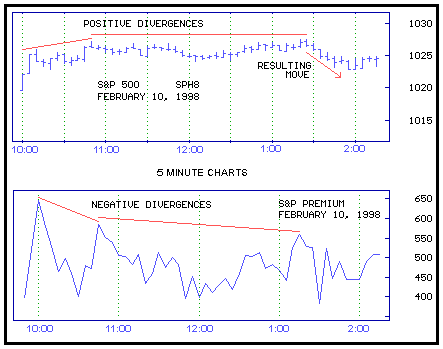
| |
Divergences are very powerful indicator tools but must be used with discretion, especially in strongly trending markets. (Some markets can form divergences for years!). One of the strongest signals in technical analysis is divergence combined with volume studies.
Look for and use divergence with market internals -- they will point the way to profit.
|
|
|







 There
is a risk of loss in futures trading.
There
is a risk of loss in futures trading.